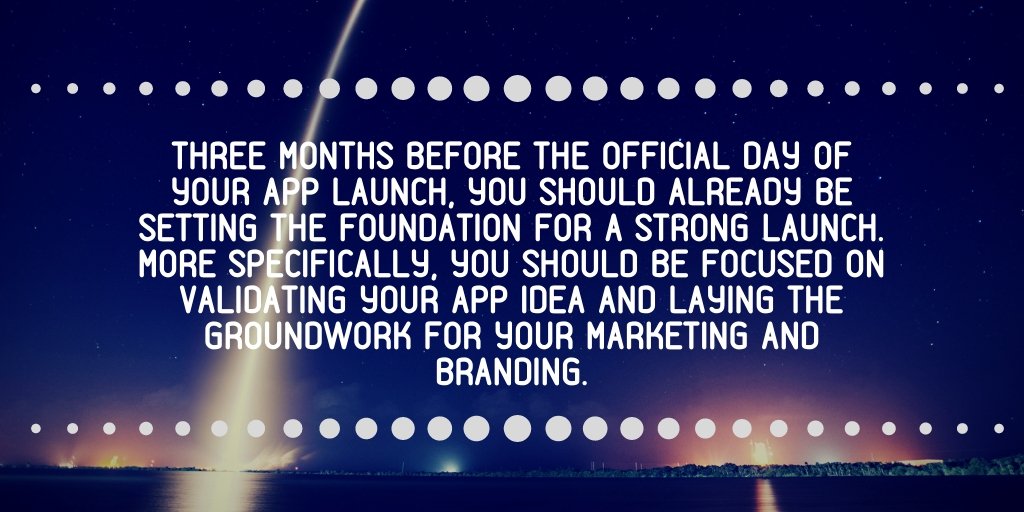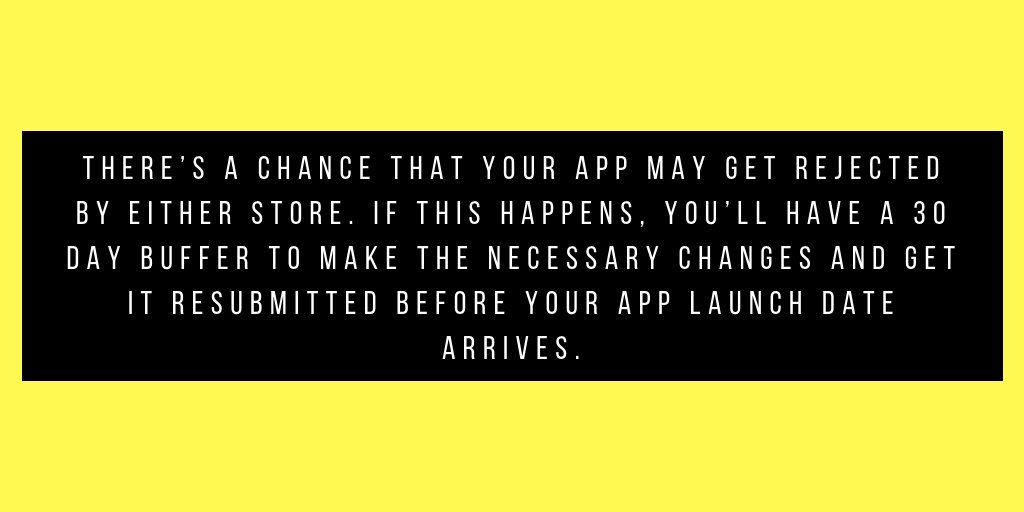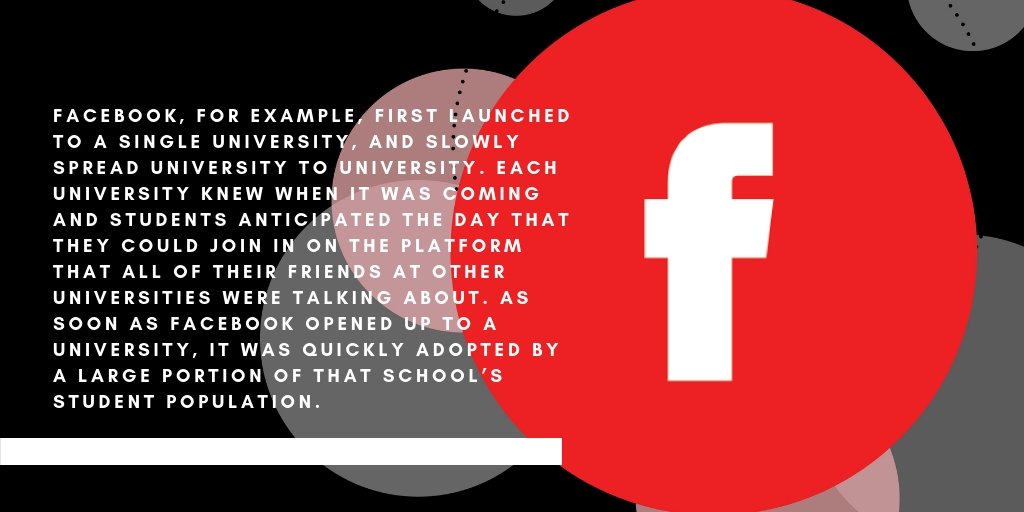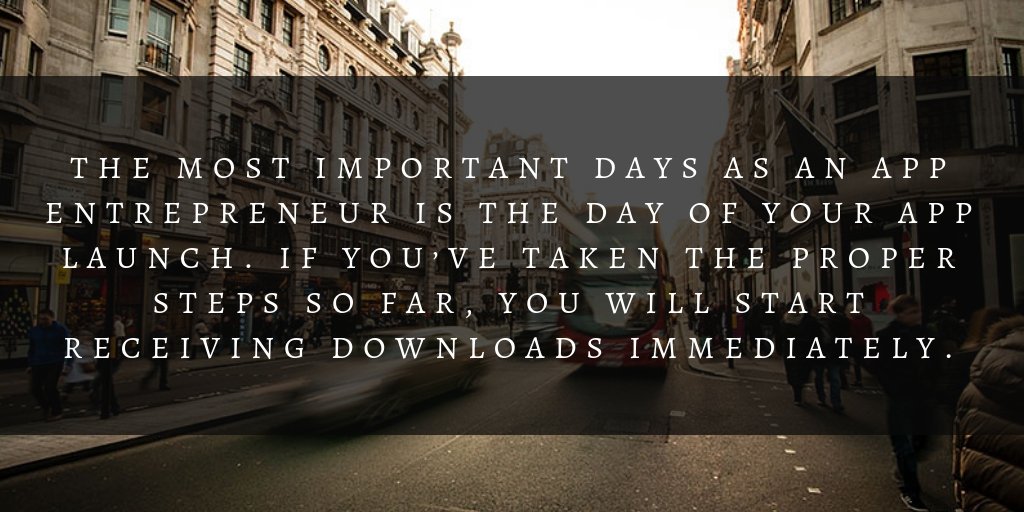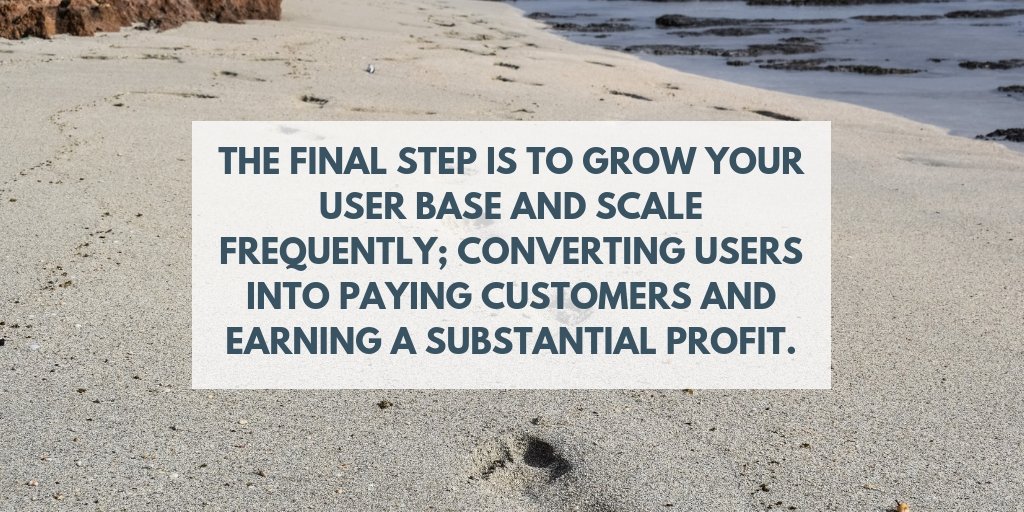To the masses, it may seem like successful apps just pop up one day and achieve magnificent success without much effort. However, anyone who has ever launched an app before knows the truth – a successful app launch takes serious work and getting people to your app is not easy.
While a great app idea may start at a hackathon, most apps aren’t built overnight… or in a week… or within a month. According to a study by Goodfirms, it takes an average of 3-5 months to fully build out and launch a mobile app. Why does it take so long? An app launch doesn’t just rely on how quickly your app developers can code it – but also includes many other steps like customer research, concept validation, pre-launch marketing, and more.
To build a successful startup and experience a strong app launch, there are many factors that need to be in place before, during and after you push your app to the app stores. If you’re just starting development today, you’ve got at least 90 days to get everything together before launching. In this guide, we’ll guide you through each step that you need to take as you approach the day of your app launch.
Phase I – 90 Days Before Your App Launch
Three months before the official day of your app launch, you should already be setting the foundation for a strong launch. More specifically, you should be focused on validating your app idea and laying the groundwork for your marketing and branding.
Validate Your Assumptions
Before taking on the expensive journey of building a new piece of software, it is critical to validate your concept; proving that there is actually a market experiencing a specific problem, and that your product is the solution that the market is looking for to solve that problem. Not every app startup will change the world like Facebook or Uber, but there are thousands of highly successful apps that simply solve a small problem for a large number of users.
True market disruption comes when a founding team creates an app that solves a problem that no other solution exists for. However, you don’t have to be the first to market to succeed as an app startup, you just need to solve the problem better or more effectively than other competing solutions. Consider how some of our favorite apps solve our largest problems:
- Uber solved transportation problems for citizens, making it easier to procure a ride without waiting on a taxi. Furthermore, Uber made it simple for the average person to earn extra income by monetizing their automobile and free time.
- AirBnb simplified the property booking process by giving easy access to short-term rental options outside of the traditional hotel. Furthermore, it made it easy for property owners to earn an income without a long-term tenant, by monetizing their property through the platform.
- Tinder didn’t solve a new problem. Online sites like Match were already leading the market – but they were expensive to use and was a huge commitment for the average person looking to casually date. Tinder made it easy for singles to mingle with other singles by literally bringing dating right to their fingertips. A simple swipe of the screen can generate a new dating relationship without the huge monthly commitment of other dating solutions.
Believing that your concept is the best solution for your market isn’t enough. Your ‘belief’ can quickly lead you to blowing through your development budget only to find that your audience doesn’t believe in your solution as much as you do. There’s something that’s better than great assumptions – validation through real data. No matter what, you will validate your app – you’ll either validate it early on, or you’ll use all of your resources to build it and then validate that there is a major flaw when no one downloads it. Successful apps are able to validate their assumptions early on and pivot where necessary to ensure that they are building the type of solution that is truly in demand by users experiencing a specific problem.
There are several ways to validate an app idea, including:
- Smoke Tests – The purpose of a smoke test is to determine buyer intent as cheaply as possible. In practice, a smoke test gives the impression that there is a product to be purchased, even when the product hasn’t actually been built yet. An example of a smoke test could be a landing page that explains the functionality of an app, displays several app design screens and allows users to ‘purchase’ a subscription. The ‘smoke’ part of the test is that there is no product to be purchased because it doesn’t yet exist. This allows startups to test how many people would be interested in the application if it already existed; giving them immediate clarity on whether it is worth it to go forward in building out their app concept. Smoke tests can be built and executed rather inexpensively but can provide an incredible amount of insight to make your app launch more successful.
- Crowdfunding – Platforms like Kickstarter and Indiegogo give startups the opportunity to pre-sell their product or service and raise the funds to build it. Pre-selling is a great way to prove demand for your app before it’s official launch. App startups that are able to crowdfund successfully have an additional advantage since they are usually able to generate enough capital to build at least an initial minimal viable product (see below), are able to build strong brand awareness and are able to sign up thousands of customers months before their app launch.
- Minimal Viable Product (MVP) – Launching a minimal viable product is another excellent method for proving your concept and validating your assumptions on all aspects of your application. A minimal viable product is a stripped down version of the product that only includes enough features to satisfy early users. In terms of apps, an MVP will be a real and launched application but stripped down to only its core features. This allows developers and app startups to launch their software quicker and with a smaller budget, but be able to attract early adopters in order to generate insights and feedback. Instead of spending tens or hundreds of thousands of dollars to build a full-featured app that may or may not succeed in the market, an MVP only includes very few features to test interest and usage behavior before developing further features.
Lay The Groundwork for Branding & Marketing
Marketing is critical to the success of any startup, and you don’t actually need a launched product to start communicating with your audience and building brand awareness. If your plan is to wait until your app is already on the market before you decide to begin building the foundation for your branding and marketing, you will be seriously behind the ball on the day of your app launch.
Ninety days before your app launch, take the following steps to build a strong branding and marketing foundation:
Buy a domain and launch your website:
At some point, your app will need a website, and the sooner you launch a site that explains the features of your upcoming app, the quicker you can start building up anticipation from potential users. A website for your app gives you many benefits – you can offer pre-registration, showcase demos of your application, generate feedback and use it to launch a content marketing campaign. Furthermore, setting it up early ensures that you align your app name and website domain.
Create all your social media handles:
Marketing through social media is one of the most effective ways for app startups to reach their audiences. Lay the foundation by creating all of your social media handles on the various social platforms such as Facebook, Twitter, Instagram, Pinterest, Reddit, and others. Even if you don’t think you’ll use a certain platform, having your app’s handle there ensures that if you ever change your mind, you will already own the appropriate handles.
Become part of the community:
If you know exactly who your target audience is, it isn’t hard to find them. In many cases, your audience has probably already organized itself into a community on a platform like Facebook, LinkedIn or Reddit. Become active in these communities and groups, but don’t start immediately advertising your app and annoying everyone. Instead, engage with them – answer their questions, get in on the action, learn about their likes and dislikes, and identify their complaints about your competitors. These groups are a highly valuable source of market research, and after you establish yourself as an expert; advertising your solution will be perceived as an expert recommendation instead of an annoyance.
Phase II – 30 Days Before Your App Launch
If you’ve been building your app according to lean startup principles, you should have some core product built for testing with early adopters – even before the full app that will be launched to the public is completely developed. Thirty days before your initial launch, you want to start testing your software to validate your assumptions and kicking off your marketing plan. Here are several steps that should be taken a month before your app launch date.
Submit MVP To The App Store
Even though your full-version app may not be ready, you should still submit your minimal viable product (core-features only) to the appropriate app stores. Be sure to take a look at all the guidelines for both the Google Play Store and the Apple App Store to make sure your app meets their submission guidelines.
Why submit your app 30 days in advance? There’s a chance that your app may get rejected by either store. If this happens, you’ll have a 30 day buffer to make the necessary changes and get it resubmitted before your app launch date arrives.
Invite Beta Users For Testing
After your app has been successfully submitted to the appropriate app stores, launch it in beta – an initial private launch that allows only invited guests to access, download and use the application. Fortunately, both app stores (Google and Apple) allow developers to invite users to test their apps before officially launching it.
Don’t launch your app without beta testing it first. A beta test is basically a dry run that allows you to test each feature, discover any bugs, and gain valuable feedback from your users. Furthermore, it will help you identify any final improvements you need to make before the official launch and will help you earn some initial reviews.
How do you find initial beta users to invite? If you’ve completed the previous steps, you’ll already be in the right position – you will have a list of pre-registered users from your website, as well as an expert presence in several communities and groups. People who need your solution will be more than happy to be invited as a beta user, you just have to let them know that the opportunity exists.
Kickstart Marketing Activities
What does a failed app launch look like? It’s when you’re anticipating your launch for a whole month, and then on the day you launch, not a single user downloads your app. It can be a depressing day for those who are not prepared. Due to this, it is essential that you kick off your app marketing activities early on to start building up brand awareness and anticipation throughout your market. Here are three marketing activities you can focus on thirty days before your app launch:
Create Marketing Materials:
Ideally, you want to have strong marketing assets ready to go on the day of your app launch. It takes time and effort to optimize a marketing campaign for ideal conversion, and time will be wasted if you wait until the day of your app launch to start producing your marketing materials. Focus on high converting assets like the content for your app’s website landing page and creating engaging promotional or explainer videos that will draw interest from consumers.
Develop and Market Your Content:
Many app startups fail to take advantage of one of the most effective marketing strategies out there – content marketing. Developing great content has two major advantages. First, it allows you to establish your brand as a leading industry expert. Second, if optimized correctly, content can help you rank for important keywords on search engines like Google, which can drive organic and free traffic directly to your application.
Optimize Your App Store Listing:
According to Forrester, 63% of apps are discovered through app store searches. Just like ranking on Google, ranking highly in the app store can bring significant traffic at no cost. Optimize your app listing using ASO best practices to ensure that potential users can find your app when they are looking for a great solution.
Phase III: 7 Days Before Your App Launch
A week before your app launch, you want to start building anticipation amongst your audience. When users are excited about a new app release, they will rush to download it as soon as they are able to. Facebook, for example, first launched to a single university, and slowly spread university to university. Each university knew when it was coming and students anticipated the day that they could join in on the platform that all of their friends at other universities were talking about. As soon as Facebook opened up to a university, it was quickly adopted by a large portion of that school’s student population.
Likewise, you want to build anticipation for your application and get the word out that your app launch is coming soon. Here are a few ways to start spreading the buzz about your upcoming app launch:
Build Strong Media Relationships
One of the quickest and most effective ways to gain the trust of an audience is to gain the trust of people that they trust. Sure, you can acquire customers by persuading them one-by-one; but media and influencer relationships allow you to immediately reach pre-existing networks with the backing of a credible source. Building strong media relationships can be a difficult task, and it takes some practice to learn how to reach out to influencers and journalists successfully. Many businesses choose to hire Public Relations agencies who already have contacts so they can gain coverage sooner. Whether you hire a PR agency or choose to do it yourself, here are a few tips to getting your app mentioned by the right people, shortly before the day of your app launch:
- Contact Influencers – Look for individuals that influence your market; whether they are on Twitter, YouTube, Instagram, or anywhere else. An influencer is someone who possesses enough power to sway the purchase decisions of individuals who follow them. ‘The Oprah Effect’ for example, is a phrase that was coined to explain the influence that Oprah Winfrey had over her viewers for the last couple of decades. A simple mention on her show immediately transformed never-before-heard-of businesses into multi-million dollar brands. Maybe you can’t reach Oprah, but there are thousands of influencers out
there from social media influencers to published industry leaders. Identify who these influencers are in your industry. They may not have millions of followers, but even someone that can influence several dozen people to try out your app may be valuable to your mission. Contact them and introduce them to your
software. Offer them a free trial or invite them to your beta, and ask them for their feedback. If they like it, they may mention your app on their blog, podcast, YouTube video, or even just share it with their social media following – providing you with valuable exposure. - Pitch Your Brand Story To Journalists – Brands need their stories exposed, and journalists are always looking for great stories to write about. This creates a mutually beneficial relationship between entrepreneurs and the media. However, a great story has to really be extraordinary – nobody really cares about a new app that no one has ever heard of. Instead, find the parts of your story that really matters. Do you have a fantastic founder story or some never-before-seen industry data that would be interesting to those in your industry? Find the angles that give the most light to your business and pitch it to journalists that write for the publications that your audience read. The amount of exposure you can get a week before your app launch will directly relate to the number of downloads you can expect on the day you launch.
- Showcase Your Expertise With Guest Posts – Many blogs also often look for new and interesting content that they can expose to their audiences. Identify which blogs are most popular among your market, and offer to provide an expert article to that blog. By guest posting articles on popular blog sites, you can directly reach large established networks that may have been impossible to reach previously.
Setup Analytics and Tracking Software
The day of your app launch, you’ll need to start measuring KPIs and tracking app metrics to analyze how your software is performing. Without the right software in place, you will be unable to collect the metrics needed to optimize your strategy and progress the success of your application. There are many metrics that can be tracked, and here are some awesome analytical tools that you can use to measure your app’s performance:
- Flurry is an analytics tool that allows you to measure how many users you have, what actions they are taking when using your app, and what pages they are dropping off at. Furthermore, Flurry provides a report any time there is an error or crash; and allows you to track revenue, sales, events and other important metrics.
- Apple App Analytics is Apple’s developer analytics tool. This tool offers in-depth reports on the performance of your app store listing, gives you an overview of your user engagement metrics and provides detailed reports on crashes and bugs.
- App Annie allows you to easily access an in-depth analysis about your app’s performance over any period. You can measure unique metrics like the performance of your keywords, your position on store charts, cross-app usage and much more.
In addition to your app tracking software, it’s also a good idea to make sure you are subscribed to and setup with all relevant marketing software as well. If you’re using apps like Mailchimp, Squarespace, Buffer, Unbounce, ActiveCampaign or another marketing software, ensure that your subscriptions are up to date and that your marketing materials (like email marketing scripts) are already put together and ready to send.
Decide On A Monetization Strategy
Apps can be expensive to grow over the long run. While some app startups turn to investors for funding, many successful app startups are able to sustain their initial growth through earned revenue. How much you charge for your product or service – and how you charge – depends on what your app is, how it works, and how much your audience is willing to pay. For example:
- Minecraft and Afterlight are successful apps that charge up-front for full access to the application.
- Headspace and Evernote rely on a subscription model, requiring users to pay a monthly fee to access and operate the software.
- Fortnite and Pokemon Go rely on in-app purchases to earn revenue and monetize their users.
- Social media sites like Facebook don’t charge anything to users, but instead, charge advertisers to promote ads directly to their users.
According to statistics however, the most successful model for most apps is the freemium model. With this monetization approach, users are able to access a basic version of the application for free; but if they want to access additional features, they must upgrade to a premium monthly subscription. This model allows developers and app entrepreneurs to capture a broad audience and transform a handful of these free users into paid customers.
For more information about monetizing your mobile app, check out the article, “How To Identify The Most Profitable App Business Model”.
Phase IV: The Day Of Your App Launch
One of the most important days as an app entrepreneur is the day of your app launch. If you’ve taken the proper steps so far, you will start receiving downloads immediately. The day of your app launch, there are two major steps you should take – announcing your launch and measuring your app metrics.
Announce The Launch of Your App
Remember a month ago when you started interacting in different social communities and built a widespread email list of interested consumers? Today is the day you can finally take advantage of the relationships you have built. Announce the launch of your app on your social media pages and send an email out to your list. Remind them of the benefits of your application and provide them with a link where they can access your software immediately.
Furthermore, send out a press release and a link to your app to reporters and influencers that you have built relationships with. Invite them to download the application and encourage them to share it with their audience. Influencers have power, and this power can give you a major advantage. Offer influencers an incentive to check out your app; maybe consider giving them free access to a premium package or some initial credits for in-app purchases.
There is much benefit in driving traffic on day one. Apps with promising traction can end up in the “New and Noteworthy” or “Trending Apps” categories; making it quickly visible to millions of users.
Start Analyzing Your App Metrics
Since you have already decided which metrics you need to track and have setup the right software to do so; now you need to start actually analyzing these metrics. At minimum, on day one you should begin measuring your number of downloads, active users and engagement metrics like Daily Active Users, Monthly Active Users and Number of Sessions Per Day.
Furthermore, stay in tune with customer feedback and seek to quickly identify any bugs, crashes or weaknesses on your app. Users can be unforgiving towards an inconsistent app that is heavy with bugs. Software isn’t always perfect, but quickly identifying and fixing any bugs will be critical to establishing an exceptional user experience.
Phase V: App Success For The Long-Term
Assuming you’ve accomplished each of the previous steps, you will now have a strong foundation for a successful mobile app. The final step is to grow your user base and scale frequently; converting users into paying customers and earning a substantial profit. But how do you get there? Here’s a couple tips:
- Analytics Tell The Real Story – Your app metrics will always give you the real story on how well your app is performing. Just having downloads isn’t enough – over time, it’s also important that you know how well you are converting these users into customers, how much each customer is worth, what your Net Promoter Score is, cost per acquisition and more. The more that you understand your app metrics, the better you will understand your users; and the more you understand your users, the better you will be able to deliver them the most effective solution.
- Keep Your Users Happy – Always pay attention to what users are saying about your app in your reviews, on social media, and online. Sometimes you will have an unhappy customer (or ‘detractor’) that may say negative things about your solution. Every app has a few dissatisfied customers, but if you see a pattern of many users complaining about the same thing then it may be a sign that you need to quickly make changes to better serve them.
- Never Stop Promoting – Always continue to improve and optimize your marketing campaigns. Continue building strong relationships with influencers and media; continue to interact with consumers on social media; and continue to optimize each technique for better performance. As you scale, your marketing strategy will become even more important.
The day of your app launch will either be a major success or a major failure, but if you follow these tips effectively, you can almost ensure that you will receive at least some positive traction on your first day of app launch.
The first step to launching an app is actually building one, and we’d love to help! Our team of startup experts and app developers know exactly what it takes to bring your idea to life. Contact us to setup a free consultation today!




